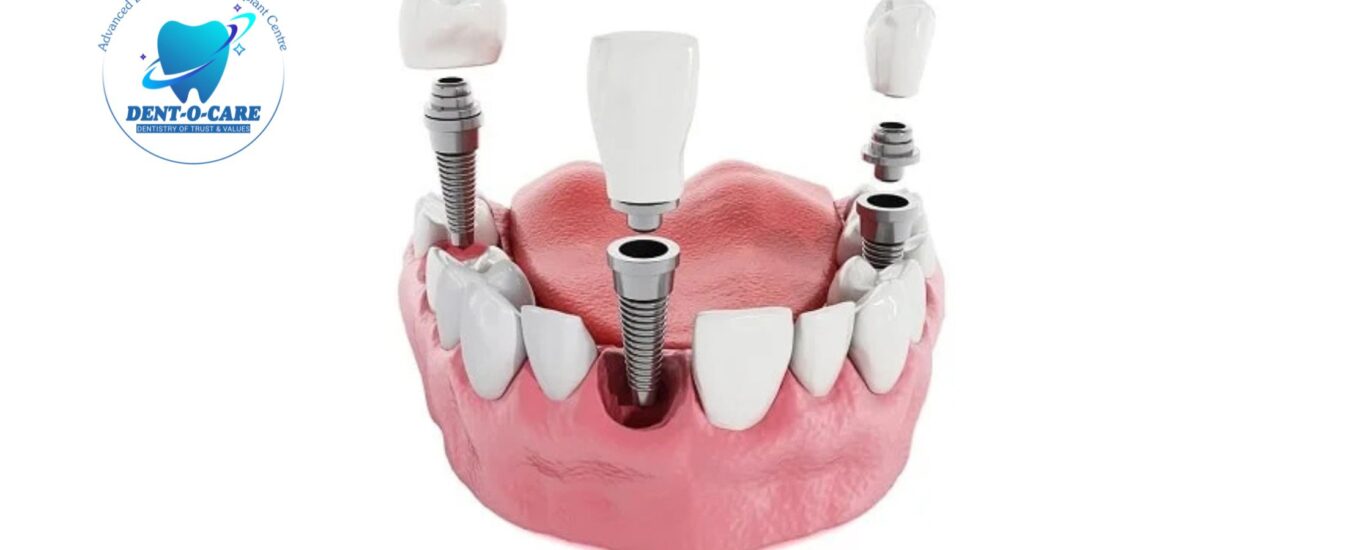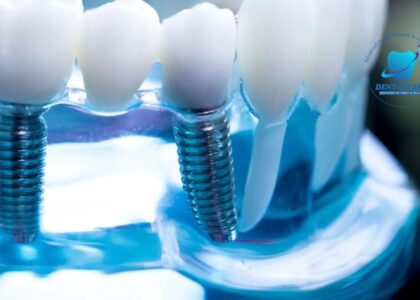Best Dental Implants Services by Dent-O-Care
Losing a tooth can affect more than just your smile. It can make chewing difficult, lower your confidence, and even change the way your face looks over time. Luckily, dental implants have become one of the best and most trusted ways to replace missing teeth. They don’t just look natural — they also feel and function like real teeth.
In this blog, we’ll explain everything you need to know about dental implants — what they are, how they work, their benefits, possible risks, costs, and how to take care of them. Whether you’re already thinking about getting an implant or just want to learn more, this guide will give you clear and practical information.
What Exactly Are Dental Implants?
Think of a dental implant as a small screw that works like the root of your missing tooth. It’s usually made from titanium or zirconia, both of which are safe for the human body. The dentist places this screw into your jawbone. Over time, your bone naturally grows around it, locking it in place. Once it’s stable, a crown (the visible part of the tooth) is attached on top.
The result? A tooth that looks, feels, and functions almost exactly like your original one.
Why Do People Call Implants the “Best” Tooth Replacement Option?
There are many ways to replace a missing tooth — dentures, bridges, or implants. But implants are often considered the gold standard because:
- They stay in place — no slipping or clicking
Implants are fixed directly into the jawbone, which makes them stable and secure. Unlike dentures, they don’t move around when you talk, laugh, or eat. - They protect your jawbone from shrinking
Missing teeth can cause the jawbone to weaken and shrink over time. Implants act like natural roots, keeping the bone strong and preventing changes in your face shape. - They last for years with proper care
Made from durable materials like titanium and zirconia, dental implants are built to last. With good hygiene and regular check-ups, they can serve you well for decades. - They look completely natural
The crown on top of the implant is designed to match the color and shape of your real teeth. This makes the implant blend in perfectly with your smile. - They don’t harm nearby teeth
Unlike bridges that rely on trimming down healthy teeth, implants stand on their own. This keeps your surrounding teeth safe and strong.
How the Dental Implant Procedure Works
Getting a dental implant isn’t a single-day event. It’s a process that happens in steps:
- Consultation & Checkup
During the first visit, the dentist carefully examines your mouth and teeth. X-rays or 3D scans are taken to check your jawbone and plan the implant treatment accurately. This step ensures the procedure is safe and tailored to your needs. - Preparation (if needed)
Before placing the implant, some patients may need extra treatment to make the jaw ready. This can include bone grafting to strengthen weak areas or gum treatment to ensure healthy tissue. These steps help the implant heal properly and last longer. - Placing the Implant
The dentist carefully places the implant screw into your jawbone. The procedure is usually done under local anesthesia, so you shouldn’t feel pain. This step forms the strong foundation that will hold your new tooth securely. - Healing Time
After the implant is placed, your jawbone gradually fuses with it over a few months. This process, called osseointegration, is essential for creating a strong and stable foundation for your new tooth. - Adding the Abutment
Once the implant has fully healed and fused with the jawbone, the dentist attaches a small connector called an abutment. This piece will hold the crown securely in place and complete the structure of your new tooth. - Placing the Crown
After the abutment is in place, a custom-made crown is attached on top of the implant. This crown is designed to match the shape, size, and color of your natural teeth, giving you a fully functional and natural-looking smile.
Benefits of Dental Implants
- They let you eat your favorite foods again.
- They look like natural teeth — no one can tell the difference.
- They stop bone loss, keeping your face shape intact.
- They’re comfortable and stable — no glue, no slipping.
- They can last a lifetime if you take care of them.
Risks and Complications
Although implants are very safe, like any medical procedure, there can be risks:
- Infection at the implant site: As with any surgical procedure, there is a small risk of infection around the implant. Proper hygiene and following your dentist’s instructions can greatly reduce this risk.
- Nerve damage (rare): In some cases, placing the implant may affect nearby nerves, leading to temporary or, rarely, permanent numbness, tingling, or discomfort in the lips, gums, or chin.
- Sinus problems if placed in the upper jaw: Implants in the upper jaw near the sinus cavity may sometimes cause sinus issues. Dentists carefully evaluate this area beforehand to avoid complications.
- Implant failure if the bone doesn’t heal properly: For the implant to succeed, the jawbone must fuse with it. If the bone doesn’t heal or integrate correctly, the implant may fail. Factors like bone quality, smoking, or certain health conditions can increase this risk.
The good news? These risks are rare, and success rates are above 90–95%. Choosing an experienced dentist and following aftercare instructions greatly reduces the chance of problems.
Cost of Dental Implants
The cost can vary widely depending on:
- How many teeth need replacement: The total number of missing teeth plays a major role in determining the overall cost of dental implants. Replacing a single tooth is less expensive than replacing several teeth or a full arch, as multiple implants may be required.
- Whether you need bone grafting or extra treatments: Some patients may require additional procedures before getting implants, such as bone grafting to strengthen the jaw or gum treatments to ensure healthy tissue. These preparatory treatments can affect both cost and the overall timeline for the procedure.
- The type of implant and crown material: Implants are made from different materials like titanium or zirconia, and crowns can vary in quality and durability. Premium materials tend to last longer and look more natural, which can influence the price.
- The clinic’s location and expertise: The experience of the dentist, the technology available at the clinic, and the clinic’s geographic location can all affect cost. Clinics with advanced equipment and highly trained specialists may charge more, but often provide higher precision and better long-term results.
While implants are usually more expensive than other options, most people see them as a long-term investment because they last so much longer.
Success Rates and Longevity
- Implants have one of the highest success rates in dentistry — more than 9 out of 10 are still working perfectly even after 10 years.
- With proper care (good hygiene, no smoking, regular dental visits), they can last a lifetime.
How to Care for Dental Implants
Taking care of implants isn’t difficult — it’s almost the same as caring for natural teeth:
- Brush twice a day.
- Floss or use interdental brushes to clean between teeth.
- Visit your dentist regularly for checkups.
- Avoid habits like nail biting, chewing ice, or grinding teeth.
The Future of Dental Implants
Dentistry is advancing quickly. New technologies are making implants safer, faster, and more comfortable. Some upcoming trends include:
- 3D printing custom implants for a perfect fit: Modern dental technology now allows dentists to create implants and crowns using 3D printing. This ensures that each implant is perfectly shaped to fit your jaw and align with your other teeth, resulting in a more comfortable and precise fit.
- Ceramic (zirconia) implants for people who prefer metal-free options: Zirconia implants are a metal-free alternative to traditional titanium implants. They are not only strong and durable but also highly aesthetic, as their natural white color blends seamlessly with the surrounding teeth. This option is ideal for patients with metal sensitivities or those who want a completely natural-looking smile.
- Guided surgery using digital scans for more accuracy: Digital scans and guided surgery technology allow dentists to plan implant placement with extreme precision. Using 3D imaging, the dentist can determine the exact angle and depth for each implant, reducing the risk of complications and improving long-term success rates.
- Same-day implants in some cases, where a crown can be placed immediately: In certain situations, it’s possible to place the implant and attach the crown on the same day. This advanced approach, often called “immediate load” or “teeth-in-a-day,” gives patients a fully functional and natural-looking tooth much faster than traditional methods, making the treatment more convenient and efficient.
Conclusion
Dental implants have truly changed the way people restore their smiles. They don’t just fill gaps — they bring back confidence, function, and long-term oral health. While the process takes time and costs more than other options, implants are often the most reliable and natural-looking solution.
If you’re missing teeth and wondering about the best option, dental implants are worth considering. Always discuss with a qualified dentist to understand what’s right for your personal situation.









